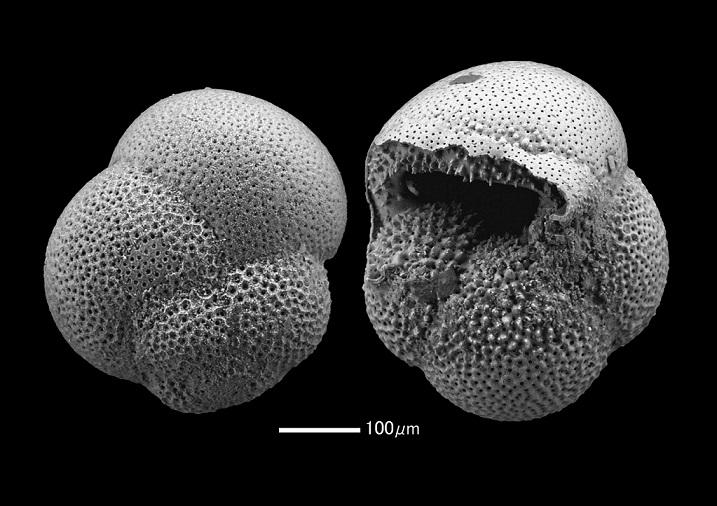Bulletin of the Geological Survey of Japan Top Page
Bulletin of the Geological Survey of Japan Vol.69 No.4 (2018)
Cover photograph | Table of Contents | Abstract
Cover photograph
Planktonic foraminifera Pulleniatina obliquiloculata (Parker and Jones) from core GS-UR-1, Urawa, Saitama City, central Japan.
The photograph is of planktonic foraminifera Pulleniatina obliquiloculata (Parker and Jones) preserved in the sample UR-76 of core GS-UR-1 (depth 76.25–76.15 m), Urawa, Saitama City, central Japan. In its adult stage, the foraminifera develops a characteristic glossy layer on its test surface due to secondary calcification, which makes it easily distinguished from other species. However, those in the photograph are too young to have the feature. In core GS-UR-1, this species was collected in the level of UR-76–UR-81 (depth 78.40–76.15 m), which corresponds to the Yabu Formation of the Shimosa Group. This species is a tropical planktonic foraminifera and an indicator of the Kuroshio water in the Northwest Pacific Ocean. The occurrence of the species suggests that there was a warm current inflow in the Urawa area, Saitama Prefecture, during the time of sedimentation of the Yabu Formation.
(Photograph by Minoru Kaneko, Caption by Masahiro Nomura)
Table of Contents
All the pages PDF : 69_04_full.pdf [22MB]
| Title | Author | |
|---|---|---|
| Article | ||
| Fossil foraminiferal assemblages from the Pleistocene Shimosa Group in core GS-UR-1, Urawa, Saitama City, central Japan |
Minoru Kaneko, Hiroyuki Ishikawa, Masahiro Nomura and Tsutomu Nakazawa (p211-232)
|
69_04_01.pdf [21MB] |
Abstract
Fossil foraminiferal assemblages from the Pleistocene Shimosa Group in core GS-UR-1, Urawa, Saitama City, central Japan
Minoru Kaneko, Hiroyuki Ishikawa, Masahiro Nomura and Tsutomu Nakazawa
Foraminiferal assemblages from the Pleistocene Shimosa Group in core GS-UR-1, Urawa, Saitama City, central Japan are examined. From 51 samples among 98 analyzed samples obtained from the core material, 72 species in 38 genera of benthic foraminifers and 32 species in 8 genera of planktonic foraminifers were identified. Based on the foraminiferal assemblages, 13 foraminiferal zones such as Zones I–IV of the Jizodo Formation, Zones I–III of the Yabu Formation, Zone I of the Kamiizumi Formation, and Zones I–V of the Kioroshi Formation are established in the Shimosa Group, in ascending order. The succession of the foraminiferal assemblages reveals that each formation generally represents an environmental change from an inner bay or a central bay, via a bay mouth, to a central bay, controlled by sea-level change accompanying topographic change. Peaks of the abundance of planktonic foraminifers are observed in Zone I of the Jizodo Formation and Zone II of the Yabu Formation, which indicates that the open ocean water flowed into the Paleo-Tokyo Bay at the timing, and these stratigraphic levels are potential key beds for stratal correlation.
Geological Survey of Japan, AIST
- About GSJ
- Our Activities
- Purchase guide
-
Publications and Database
- information
- Bulletin of the Geological Survey of Japan
- bull2025(Vol.76)
- bull2024(Vol.75)
- bull2023(Vol.74)
- bull2022(Vol.73)
- bull2021(Vol.72)
- bull2020(Vol.71)
- bull2019(Vol.70)
- bull2018(Vol.69)
- bull2017(Vol.68)
- bull2016(Vol.67)
- bull2015(Vol.66)
- bull2014(Vol.65)
- bull2013(Vol.64)
- bull2012(Vol.63)
- bull2011(Vol.62)
- bull2010(Vol.61)
- bull2009(Vol.60)
- bull2008(Vol.59)
- bull2007(Vol.58)
- bull2006(Vol.57)
- bull2005(Vol.56)
- bull2004(Vol.55)
- bull2003(Vol.54)
- bull2002(Vol.53)
- bull2001(Vol.52)
- Bulletin of the Geological Survey of Japan(old)
- Annual Report on Active Fault and Paleoearthquake Researches
- Reports, Geological Survey of Japan
- CCOP-GSJ Groundwater Project Report
- CCOP Technical Bulletin
- Cruise Report
- Geological Hazards
- Learning and Education
- GSJ Database Collection
- Collection of links


